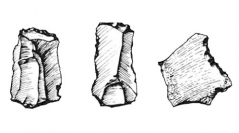

 Comptes Rendus Palevol
9 (4) - Pages 185-199
Comptes Rendus Palevol
9 (4) - Pages 185-199This article presents new accelerator mass spectrometry (AMS) radiocarbon dates of cutmarked ungulate remains from one of the uppermost archaeological layers (f) at the Grotte de Saint-Marcel, Ardèche, France. This site is situated in a key location regarding population dispersal and potential interaction between Neanderthals and modern humans, as it lies at the crossroads of two main routes of passage. Attributing the upper sequence of this site to a precise chronological period within the Mousterian was difficult until now. Previous conventional 14C analyses done on bulk samples over twenty years ago were considered too young (23,000–30,000 BP). Our new AMS radiocarbon results give two statistically identical dates of 37,850 ± 550 BP and 37,850 ± 600 BP, thus confirming the Late Mousterian attribution of the upper levels of this site. A third date overlaps them at two standard deviations. These are among the very few chronometric dates available for the Mousterian (especially its late phases) in Mediterranean France. The Late Mousterian of this zone, a key region in recent debates about late Neanderthal behaviour, is discussed in light of these results.
Late Mousterian, Mediterranean France, Radiocarbon, Neanderthal behaviour